
Projects

Colossal Core/Shell CdSe/CdS Quantum Dot Emitters
Article
Nanomaterials
Synthesis
July 2024, Seattle, Washington
Single-photon sources are essential for advancing quantum technologies with scalable integration being a crucial requirement. To date, deterministic positioning of single-photon sources in large-scale photonic structures remains a challenge. In this context, colloidal quantum dots (QDs), particularly core/shell configurations, are attractive due to their solution processability. However, traditional QDs are typically small, about 3 to 6 nm, which restricts their deterministic placement and utility in large-scale photonic devices, particularly within optical cavities. The largest existing core/shell QDs are a family of giant CdSe/CdS QDs, with total diameters ranging from about 20 to 50 nm. Pushing beyond this size limit, we introduce a synthesis strategy for colossal CdSe/CdS QDs, with sizes ranging from 30 to 100 nm, using a stepwise high-temperature continuous injection method.

A Summer Research Program for Community College Students Led by Graduate Students at the University of Washington
Article
Outreach
Chemical Education
June 2024, Seattle, Washington
Chemistry students at community colleges often experience a lack of hands-on research opportunities, which can be a significant disadvantage when they transition to four-year universities. To address this, the Summer Chemistry Research Opportunities for Community College Students (SCROCCS) was established in 2022 by graduate students at the University of Washington to provide early chemical research exposure to community college students in the Greater Puget Sound area. SCROCCS has two primary goals: (1) to provide participating students with research experience and skills crucial for their success in chemistry and related STEM fields, and (2) to offer leadership opportunities for graduate students at host universities.

Design Rules for Obtaining Narrow Luminescence from Semiconductors Made in Solution
Review Article
Nanomaterials
Photonics
June 2023, Seattle, Washington
Demand for solution-processed semiconductors in optoelectronics, from displays to quantum light sources, hinges on their adaptability and integration ease. A key requirement is narrow photoluminescence line width for color and photon purity. This review explores colloidal emitter requirements, spectral broadening sources, and compares current materials' emission line widths, concluding with future prospects.

Deterministic Quantum Light Arrays from Giant Silica-Shelled Quantum Dots
Article
Nanomaterials
Photonics
December 2022, Seattle, Washington
This study presents a technique for precisely placing single colloidal quantum dots (QDs) into arrays while preserving their photostability and photon emission qualities. By encapsulating CdSe/CdS core/shell QDs in silica, their size is increased without affecting quantum emission, enhancing photostability. The resulting 'giant QDs' are orderly positioned using template-assisted self-assembly, achieving a 75% success rate. These QDs maintain their antibunching behavior and optical properties at room temperature over time, providing a scalable approach for quantum photonics platforms using QDs as single-photon emitters.

Predicting Indium Phosphide Quantum Dot Properties from Synthetic Procedures Using Machine Learning
Article
Nanomaterials
Machine Learning
July 2022, Seattle, Washington
This research explores using machine learning (ML) to predict the outcomes of InP quantum dot (QD) syntheses, addressing the challenge of limited data in nanomaterials synthesis. Data from 72 publications were consolidated into a complete dataset of 216 entries, despite initial missing information, to train and test ML models. The study experimented with different ways of categorizing input features to optimize predictions. The best-performing ML model achieved low mean absolute errors for predicting absorption, emission, and diameter properties. This model is now part of an interactive web app, offering a practical tool for designing InP QD syntheses.
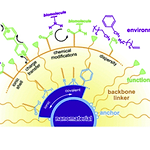
Organic building blocks at inorganic nanomaterial interfaces
Review Article
Nanomaterials
Organic anchor groups
December 2021, Seattle, Washington
This tutorial review offers insights into designing organic molecules for functionalizing inorganic nanomaterial surfaces, using the 'anchor-functionality' paradigm. This strategy, applicable to a wide range of materials (like lead halide perovskites, various semiconductors, metal oxides, diamonds, carbon dots, silicon) and applications (LEDs, photovoltaics, lasers, photocatalysis, imaging, therapy, drug delivery), involves two main components: anchor groups that bind to inorganic surfaces and functional groups for specific application optimization. The review explains the roles of different anchor and functional groups in relation to inorganic materials and external environments.

Integrated Quantum Nanophotonics with Solution-Processed Materials
Review Article
Nanophotonics
Quantum optics
November 2021, Seattle, Washington
This review article addresses the scalability challenge in quantum information science and engineering, traditionally hindered by reliance on single atoms, self-assembled quantum dots, or single solid-state defects. It focuses on the potential of solution-processed quantum materials, which, despite historically inferior quantum properties compared to solid-state emitters or atoms, are showing promise due to advancements in synthesis processes and nanophotonic engineering. These advancements include longer coherence times for emitted photons and better integration of emitters with dielectric nanocavities. The review discusses recent experiments with solution-processed quantum materials and dielectric nanophotonic structures, offering insights into their potential in overcoming scalability barriers in quantum technologies.
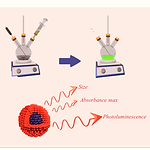
Hot Pots for Good Dots
Project
Machine Learning
Nanomaterials
March 2021, Seattle, Washington
Colloidal quantum dots, important in various fields like display technology and quantum computing, are commonly synthesized using the hot injection method. This method involves specific starting materials and conditions to produce quality quantum dots. "Hot Pots for Good Dots" is a machine learning project that predicts the properties of these quantum dots based on the starting materials and conditions. Developed using Python and Streamlit, this project was created for the CHEME-545 & 546 courses at the University of Washington in Winter 2021, under the guidance of Dr. David Beck and Dr. Stephanie Valleau. Team members include Florence Dou, Harrison Sarsito, and Benedicte Diakubama.
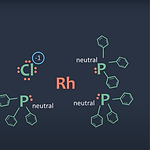
Electron Counting in Transition Metal Complexes
Tutorial Video
Chemistry
Education
December 2020, Seattle, Washington
Electron counting is an important skill for any chemistry student. This video was made as a project for the CHEM-516 course in Fall 2020 at the University of Washington with the purpose of teaching chemistry undergraduate students basic concepts in inorganic chemistry (Instructor: Dr. Brandi Cossairt).
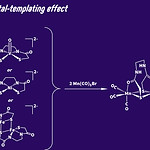
An Unusual Metal Templating Effect Switching an N2S2 Ligand to a Binucleating, Tridentate S2O2 Ligand - Undergraduate Thesis
Bimetallic
Organometallics
May 2020, College Station, Texas
This undergraduate thesis from Texas A&M University in 2020, under the guidance of Dr. Marcetta Darensbourg and mentorship of Trung Le, delves into bioinorganic chemistry, specifically the study of metalloenzymes. These natural enzymes are not only pivotal in biological systems but also serve as inspiration for designing organometallic catalysts. The research focuses on the metal-containing active sites of enzymes, particularly a tripeptide Cys-Gly-Cys biomimetic N2S2 ligand found in the acetyl-CoA-synthase active site. This ligand can encapsulate various metal cations to form MN2S2 units, which are capable of trapping additional metal ions while maintaining their structure. An unexpected result was observed when using M-ema (N,N’-ethylenebis(2-mercaptoacetamide)) as the MN2S2 ligand in reaction with Mn(CO)5Br, leading to a novel bimetallic two-manganese system with ema as a tridentate binucleating S2O2 ligand.
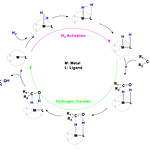
Recent Advances in Manganese(I)-Based Catalysts for Hydrogenations of Aldehydes, Ketones, and Esters - Review Article
Organometallics
Catalysts
May 2020, College Station, Texas
This critical review, created for a senior chemistry seminar at Texas A&M University in Spring 2020 under Dr. Holly Gaede, focuses on sustainable chemistry's goal of using accessible, benign, and inexpensive materials in industrial processes. It highlights the importance of enhancing catalyst activity and replacing precious metal catalysts with more abundant metals in catalytic reactions. Specifically, the review addresses the use of Mn (manganese) for hydrogenating C=O bonds as an alternative to precious metals in catalysis. MnI complexes, noted for their commercial availability, have been effectively used with various ligand systems to produce catalysts active in hydrogenating aldehydes, ketones, and esters. The review covers recent advances in hydrogenation catalysis using Mn(I).
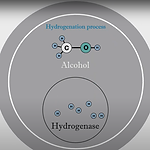
Enzyme Biomimicry and Hydrogenation
Informational Video
Biomimicry
Education
April 2020, College Station, Texas
In 2019, Dr. Xile Hu's research group at École Polytechnique Fédérale de Lausanne, Switzerland, developed a groundbreaking [Mn]-hydrogenase, emulating the apoenzyme of [Fe]-hydrogenase, known for its role in H2-activation and hydride transfer. This marked the first successful creation of a functional hydrogenase incorporating manganese, a non-native metal ion, a significant achievement in the field. As part of a senior chemistry seminar at Texas A&M University in Spring 2020, led by Dr. Holly Gaede, a video was produced for a general audience. This video aims to explain how chemists draw inspiration from biological systems to create practical solutions and applications in the real world.
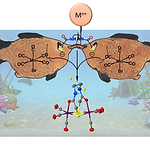
Metal‐Templated, Tight Loop Conformation of a Cys‐X‐Cys Biomimetic Assembles a Dimanganese Complex - Research Article
Organometallics
Biomimetic
December 2019, College Station, Texas
This excerpt discusses the study of mimics of biological N2S2 binding sites, particularly focusing on the ema ligand, which has been a subject of research for many years. It highlights the novel discovery of (H2ema)2- acting as a binucleating ligand through both carboxamide oxygen and thiolate sulfur, a phenomenon previously unknown or unreported. The synthesis of this new manganese(I) complex underscores the intricate metal exchange processes and proton/metal competitions, drawing parallels to the synthetic pathways used in the creation of metalloproteins and enzymes.
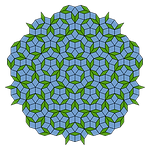
Quasicrystals – A Captivating Exception
Informational Paper
Mathematics
Symmetry
October 2019, College Station, Texas
This paper, written for the Foundation of Mathematics Course at Texas A&M University in Fall 2019 under instructor Oksana Shatalov, delves into the fascinating world of crystal structures, long admired in science for their periodic and ordered patterns. Traditionally, scientists identified crystals through the crystallographic restriction, which involves the arrangement and symmetry of atoms. However, the discovery of quasicrystals by Shetchman introduced a novel material category that challenges conventional crystallography. Quasicrystals are characterized by their aperiodicity and unique 5-fold rotational symmetry, expanding the understanding of crystalline structures. This breakthrough has sparked interest and potential applications across various fields, including mathematics, chemistry, crystallography, and materials science.

Child Soldiers Prevention Website
Informational Website
Humanity
Education
December 2017, Puyallup, Washington
This interactive website was created as a term project for an English 101 course at Pierce College in 2017, taught by Alison Walker-Stromdahl. It aims to shed light on the critical issue of child soldiers, a situation where it's estimated that 200,000 to 300,000 children in twenty countries are involved in war activities. Alarmingly, 71% of these children are under the age of 15, with the majority being active in Africa and the Middle East. The website serves as an educational and awareness platform, featuring blogs, an interactive game, and various resources, all focused on the problems associated with child soldiers and their plight around the world.